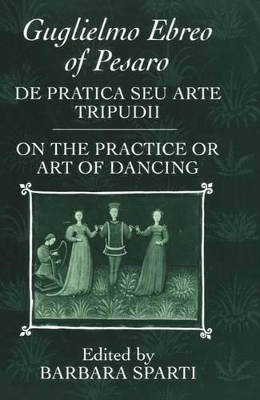Clarendon Paperbacks
1 total work
Fifteenth-century Italy produced the earliest known treatises on the dance. Guglielmo Ebreo, an eminent Jewish dancing master, dedicated his `On the Practice or Art of Dancing' to the future Sforza duke of Milan in the determination to give dance the status enjoyed by music and other arts and sciences. He included not only choreographies (subsequently likened to the artistic achievements of Machaut, Leonardo, Dante, and Petrarch), but a Defence of the Dance, a
Socratic dialogue, and theoretical precepts - still valid today - which clearly reflect the contemporary humanistic aesthetic and ideals. Challenging exercises (such as dancing counter to the time of the music!) and advice to young ladies at balls are also described.
Barbara Sparti has provided a heretofore unavailable (rare) source book for students, amateurs, and scholars: a critical edition in Italian and a facing English translation; dance tunes in facsimile and in annotated transcriptions based on the choreographies. Recent specialized studies and archival discoveries have greatly enriched the introductory chapters on De pratica's history, the interpretation of its music, Guglielmo's life, and dancing in fifteenth-century Italy. An Appendix
containing significant theoretical, musical, and choreographic additions from a later copy also has an Autobiography describing princely festivities, replete with names of participants, locations, and expenditures, of particular import to historians and those interested in court life in the Italian Renaissance.
A Bibliography, Biographical Notes on Guglielmo's patrons, Illustrations depicting scenes of dancing, as well as a Glossary of dance, music, and humanistic terms, complete the critical apparatus.
Socratic dialogue, and theoretical precepts - still valid today - which clearly reflect the contemporary humanistic aesthetic and ideals. Challenging exercises (such as dancing counter to the time of the music!) and advice to young ladies at balls are also described.
Barbara Sparti has provided a heretofore unavailable (rare) source book for students, amateurs, and scholars: a critical edition in Italian and a facing English translation; dance tunes in facsimile and in annotated transcriptions based on the choreographies. Recent specialized studies and archival discoveries have greatly enriched the introductory chapters on De pratica's history, the interpretation of its music, Guglielmo's life, and dancing in fifteenth-century Italy. An Appendix
containing significant theoretical, musical, and choreographic additions from a later copy also has an Autobiography describing princely festivities, replete with names of participants, locations, and expenditures, of particular import to historians and those interested in court life in the Italian Renaissance.
A Bibliography, Biographical Notes on Guglielmo's patrons, Illustrations depicting scenes of dancing, as well as a Glossary of dance, music, and humanistic terms, complete the critical apparatus.
